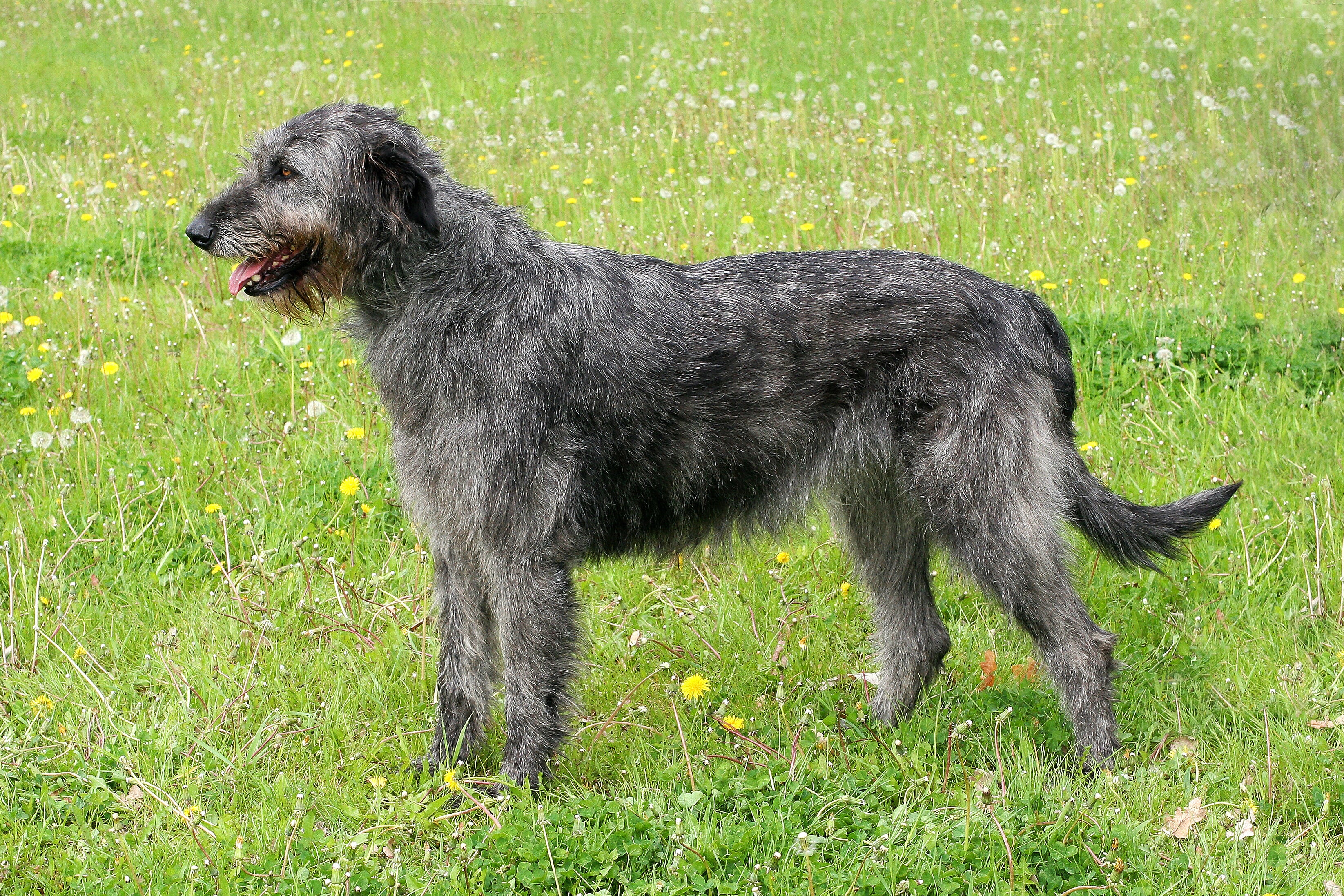Irish Wolfhound
As the tallest dog in the world, Irish Wolfhounds are handsome, hairy dogs that are surprisingly agile and speedy. They are graceful with an easy gait and a proud demeanor that can be witnessed with how high they hold their heads. Their rough coat, which provides them with protection against the wilderness, is known for its wiry appearance and extra-long strands of hair that hang over the eyes and under the jaw, giving them their trademark shabby, chic look.
Breed characteristics carousel
Learn More
Need to Know
- Suitable for experienced owners
- Extra training required
- Need to be aware of potential health issues
- Enjoys active walks
- Can be left alone occasionally with training
- Giant dog
- Some drool
- Requires regular grooming
- Quiet dog
- Welcomes everyone happily
- Generally friendly with other dogs
- May need additional training to live with other pets
- May need additional supervision to live with children
- Needs a large yard
- Can live in semi-rural areas
- AKC Registered Breed

Personality
Looking for a gentle giant whose heart is as big as their body? You’ve found them in the Irish Wolfhound. Their friendly, graceful disposition allows them to get along with just about anyone. They love to be around their humans and will crave quality time with their loved ones. They enjoy being around other dogs (though, it should be known that some other breeds may be intimidated by their size).
As puppies, Wolfhounds can be overly energetic, and boisterous, and require a lot of metaphorical hand-holding. However, it’s absolutely worth it when they reward you with their devoted love and companionship in return.
Irish Wolfhounds are an ancient breed that dates back long before the Roman Empire. In the year 391, the Romans received seven of these hounds who quickly proved to be majestic hunters. In Ireland around the 15th century, wolves were overrunning the countryside—that is until Wolfhounds were introduced, eventually causing them and most of the other native big game to go extinct in the 1700s.
In 1862, Geroge Augustus Graham began scouring the country for Irish Wolfhounds and made it his life’s work to protect and promote the breed. Today his name is still spoken with admiration among Wolfhound fanciers and is greatly credited with their domestic success.
Wolfhounds take a while to mature, up to four years on average. Owners who get younger dogs should be prepared and have realistic expectations that they will be living with a massive dog who won’t exhibit sensible adult behavior for roughly the first three years. There should be ample indoor, outdoor, and vehicle space for Wolfhounds to thrive.
Irish Wolfhounds are surprisingly active and fast given their size and they enjoy exercise, long walks, and regular daily play sessions in order to stay mentally and physically sharp.
Due to their large size, Irish Wolfhounds need a significant amount of indoor and outdoor space. A home with a securely fenced area is crucial. They should only be allowed to roam freely in areas where they can’t escape.
These hairy dogs possess a double coat consisting of a wiry outer covering and a soft undercoat. Irish Wolfhounds dogs don’t shed heavily in one season and instead, shed a moderate amount consistently throughout the year. A thorough brushing once or twice a week should do the trick to help keep them looking their best.
Wolfhounds are smart dogs and fast learners. Their desire to be around people and their sensitivity to humans make them excellent dogs for therapy work.
Wolfhound puppies are known to be a little destructive and can easily get up to no good when left home alone for long periods. They do best when they can play with other dogs who are around their own age. Early socialization and puppy training classes with positive reinforcement methods are strongly suggested. Leash training is also key to mastering as a puppy if you have any hopes of being able to take them on walks as an adult.
Irish Wolfhounds can make excellent family pets. They are quiet, friendly, and entirely devoted to their family. However, they may be too large of a dog to live with small children. Older children who can better comprehend that nothing is out of reach for an Irish Wolfhound are a much more safe and sensible option.
The cost of an Irish Wolfhound from a breeder is significantly more than the cost of adopting one from a local shelter or rescue. The adoption fee usually covers additional items such as spaying or neutering, vaccines, and microchipping.

Learn more about feeding and caring for your Irish Wolfhound on Purina.
Did You Know?
- The Irish Wolfhound is the tallest dog in the world when standing on their hind legs. Males can stand at an astounding seven feet tall.
- The Irish Wolfhound appears in Irish culture. One inscription described the dog as “Gentle when stroked, fierce when provoked.”
- The mascot of the Irish Guards is an Irish Wolfhound named Turlough Mor.
